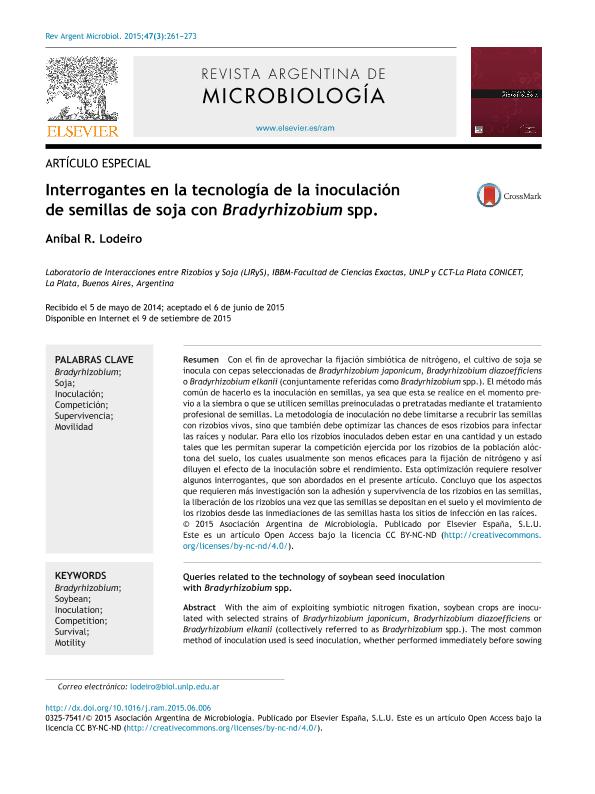Mostrar el registro sencillo del ítem
dc.contributor.author
Lodeiro, Anibal

dc.date.available
2018-06-11T20:59:01Z
dc.date.issued
2015-09
dc.identifier.citation
Lodeiro, Anibal; Interrogantes en la tecnología de la inoculación de semillas de soja con Bradyrhizobium spp.; Asociación Argentina de Microbiología; Revista Argentina de Microbiología; 47; 3; 9-2015; 261-273
dc.identifier.issn
0325-7541
dc.identifier.uri
http://hdl.handle.net/11336/48194
dc.description.abstract
Con el fin de aprovechar la fijación simbiótica de nitrógeno, el cultivo de soja se inocula con cepas seleccionadas de Bradyrhizobium japonicum, Bradyrhizobium diazoefficiens o Bradyrhizobium elkanii (conjuntamente referidas como Bradyrhizobium spp.). El método más común de hacerlo es la inoculación en semillas, ya sea que esta se realice en el momento previo a la siembra o que se utilicen semillas preinoculadas o pretratadas mediante el tratamiento profesional de semillas. La metodología de inoculación no debe limitarse a recubrir las semillas con rizobios vivos, sino que también debe optimizar las chances de esos rizobios para infectar las raíces y nodular. Para ello los rizobios inoculados deben estar en una cantidad y un estado tales que les permitan superar la competición ejercida por los rizobios de la población alóctona del suelo, los cuales usualmente son menos eficaces para la fijación de nitrógeno y así diluyen el efecto de la inoculación sobre el rendimiento. Esta optimización requiere resolver algunos interrogantes, que son abordados en el presente artículo. Concluyo que los aspectos que requieren más investigación son la adhesión y supervivencia de los rizobios en las semillas, la liberación de los rizobios una vez que las semillas se depositan en el suelo y el movimiento de los rizobios desde las inmediaciones de las semillas hasta los sitios de infección en las raíces.
dc.description.abstract
With the aim of exploiting symbiotic nitrogen fixation, soybean crops are inoculated with selected strains of Bradyrhizobium japonicum, Bradyrhizobium diazoefficiens or Bradyrhizobium elkanii (collectively referred to as Bradyrhizobium spp.). The most common method of inoculation used is seed inoculation, whether performed immediately before sowing or using preinoculated seeds or pretreated seeds by the professional seed treatment. The methodology of inoculation should not only cover the seeds with living rhizobia, but must also optimize the chances of these rhizobia to infect the roots and nodulate. To this end, inoculated rhizobia must be in such an amount and condition that would allow them to overcome the competition exerted by the rhizobia of the allochthonous population of the soil, which are usually less effective for nitrogen fixation and thus dilute the effect of inoculation on yield. This optimization requires solving some queries related to the current knowledge of seed inoculation, which are addressed in this article. I conclude that the aspects that require further research are the adhesion and survival of rhizobia on seeds, the release of rhizobia once the seeds are deposited in the soil, and the movement of rhizobia from the vicinity of the seeds to the infection sites in the roots.
dc.format
application/pdf
dc.language.iso
spa
dc.publisher
Asociación Argentina de Microbiología

dc.rights
info:eu-repo/semantics/openAccess
dc.rights.uri
https://creativecommons.org/licenses/by-nc-sa/2.5/ar/
dc.subject
Bradyrhizobium
dc.subject
Soja
dc.subject
Inoculacion
dc.subject
Competicion
dc.subject.classification
Otras Ciencias Biológicas

dc.subject.classification
Ciencias Biológicas

dc.subject.classification
CIENCIAS NATURALES Y EXACTAS

dc.title
Interrogantes en la tecnología de la inoculación de semillas de soja con Bradyrhizobium spp.
dc.title
Queries related to the technology of soybean seed inoculation with Bradyrhizobium spp.
dc.type
info:eu-repo/semantics/article
dc.type
info:ar-repo/semantics/artículo
dc.type
info:eu-repo/semantics/publishedVersion
dc.date.updated
2018-06-08T14:26:28Z
dc.identifier.eissn
1851-7617
dc.journal.volume
47
dc.journal.number
3
dc.journal.pagination
261-273
dc.journal.pais
Argentina

dc.journal.ciudad
Ciudad Autónoma de Buenos Aires
dc.description.fil
Fil: Lodeiro, Anibal. Consejo Nacional de Investigaciones Científicas y Técnicas. Centro Científico Tecnológico Conicet - La Plata. Instituto de Biotecnología y Biología Molecular. Universidad Nacional de La Plata. Facultad de Ciencias Exactas. Instituto de Biotecnología y Biología Molecular; Argentina
dc.journal.title
Revista Argentina de Microbiología

dc.relation.alternativeid
info:eu-repo/semantics/altIdentifier/doi/http://dx.doi.org/10.1016/j.ram.2015.06.006
dc.relation.alternativeid
info:eu-repo/semantics/altIdentifier/url/https://www.sciencedirect.com/science/article/pii/S0325754115000899
dc.relation.alternativeid
info:eu-repo/semantics/altIdentifier/url/http://ref.scielo.org/v9m8wm
dc.relation.alternativeid
info:eu-repo/semantics/altIdentifier/url/http://www.redalyc.org/articulo.oa?id=213041741015
Archivos asociados
